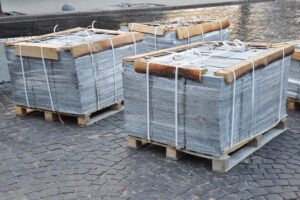Concrete is the most common building material today. Or is it cement? Is there even a difference? Most people don’t know that there is in fact a difference between concrete and cement. Both are used extensively in construction projects, landscaping projects, and other things that we use and take for granted in our everyday life. If you would like to learn more about the differences between concrete and cement, read on!
What Is Cement?
In simplest words, cement is different from concrete because cement is used to make concrete. Cement is a dry powder that is used as the binding agent along with several other ingredients to make concrete. Cement is essentially the glue that binds concrete together, and thus is really the most important part. It is likely the reason that the two words are used interchangeably.
Cement is made from kiln-heating its base materials, specifically limestone, silica, shale, clay, slate, and iron ore. These materials get so hot that they form marble balls and those are eventually ground down into powder, which is then mixed with a small amount of additional limestone and gypsum. This mixture is cement, which is packaged and shipped to concrete manufacturing plants and used to make concrete.
What Is Concrete?
Concrete is a mixture that combines cement and sand, aggregates, and water. When water mixes with cement it makes a chemical reaction called heat of hydration that makes the paste very “sticky” (meaning it binds stuff together). When sand is mixed into this process it produces a paste that is very strong. By mixing aggregates (like stone) in, the final product is even stronger. Generally concrete is made by combining 1 part cement to 2 parts sand to 3 parts stone. The amount of water should be limited to the minimum amount needed to make the mixture workable.
If you’re going to be working with concrete, it is important to keep certain safety points in mind. First, cement is a powder that is dangerous if inhaled – always practice good safety procedures. Second, fully cured concrete has great compression strength, but needs tensile reinforcement. Finally, adding too much water will cause problems with the strength of the final product while too little water will make it so that the concrete is not workable when it is poured.
Concrete Visions Will Get The Job Done Right
Concrete Visions has been working with clients for over 25 years. Our G&M Services installers are certified with the industry’s major firestop product manufacturers. As part of our firestop service, we can assess abnormal field conditions and, with the manufacturer’s technical support assistance, provide engineering judgments in a timely fashion to comply with contract specifications. Our Field Mechanics undergo ongoing training, including mandatory monthly safety meetings, weekly Toolbox Talks where safety and equipment information is shared, and training on safe work standards and safety best practices.

